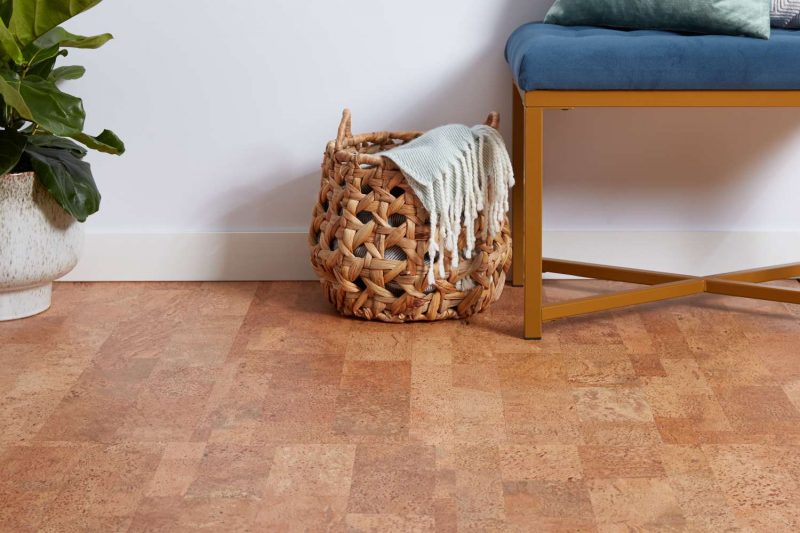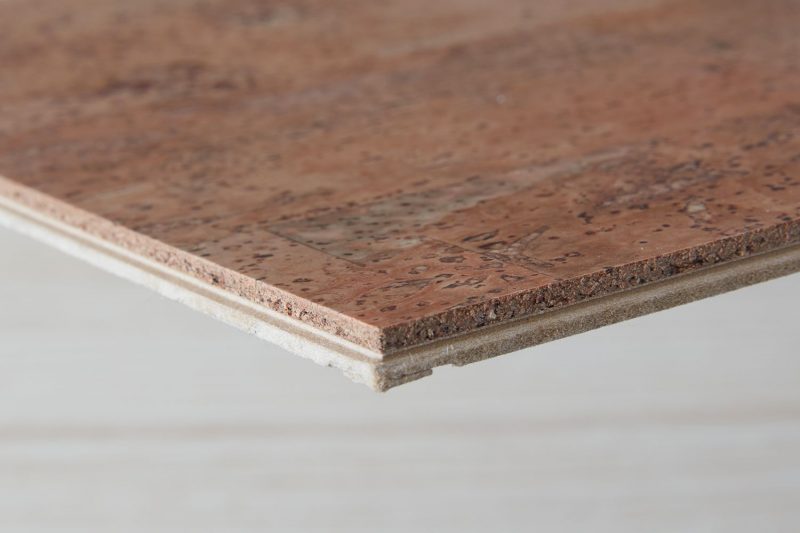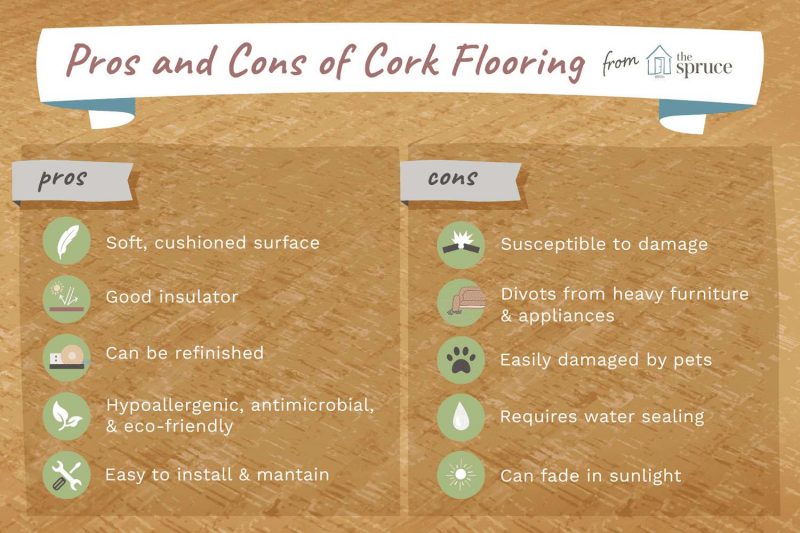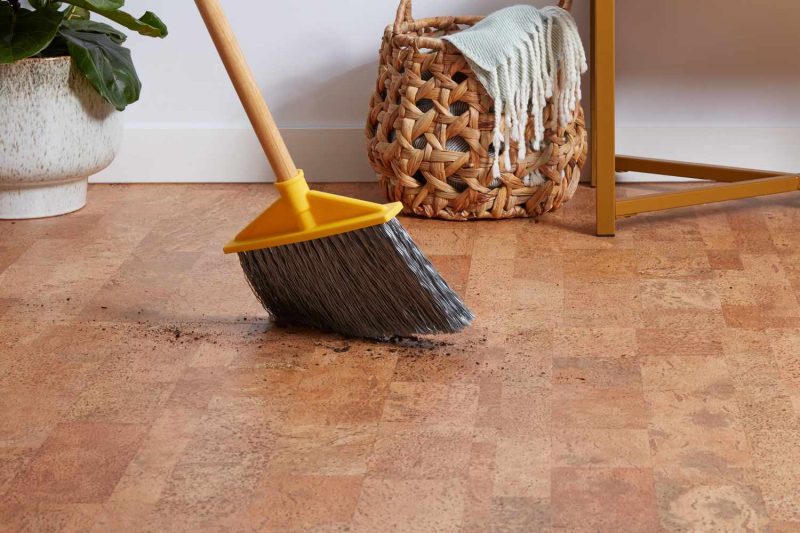The inherent ability of cork flooring to repel insects, along with its insulating properties and comfortable texture, makes it an excellent choice for various areas of the house.
Cork flooring may not be as resilient as various other flooring options and can be vulnerable to different types of damage. To make a well-informed choice about its use in a particular area, it’s essential to grasp the fundamental properties of cork.
Here are the advantages and disadvantages of cork flooring, along with essential information to consider before installing cork in your residence.
Contents
- 1 Advantages of Cork Flooring
- 2 Drawbacks of Cork Flooring
- 3 Expenses Associated with Cork Flooring
- 4 Cork Floor Care and Upkeep
- 5 Cork Floor Restoration
- 6 Cork Flooring Styles
- 7 Cork Flooring Setup
- 8 Cork Flooring Compared to Bamboo Flooring
- 9 Leading Brands of Cork Flooring
- 10 Is Cork Flooring the Ideal Choice for You?
- 11 Options for Flooring Alternatives to Cork
What is Cork Flooring?
Cork is a sustainable and renewable resource derived from the bark of the cork oak tree (Quercus suber). For the production of flooring materials, cork is crushed, compacted, and shaped into sheets that are adhered together using resins.

Advantages of Cork Flooring
There are numerous advantages to selecting cork flooring for your home instead of conventional flooring options such as hardwood or tile. Below are the benefits of cork flooring:
- Comfort: The gentle texture of cork is favored for spaces where people tend to stand for extended durations, like kitchens. Its cushioned surface can help soften the impact in case of accidental trips and falls, making it an excellent option for children’s areas and for elderly individuals who may be at risk of falling.
- Sustainable Choice: Cork is sourced from the cork oak tree, and its collection is a renewable process. The outer bark is stripped away without damaging the tree, allowing for regrowth before the next harvest. Ultimately, cork is both biodegradable and recyclable.
- Cork possesses a natural compound that effectively deters insects, which contributes to the resistance of cork flooring against the proliferation and establishment of these pests.
- Cork possesses inherent insulating properties that help regulate sound and temperature, potentially reducing your utility expenses and enhancing the comfort of your living space.
- Cork is a favored choice for DIY enthusiasts when it comes to flooring, thanks to its straightforward installation and low maintenance requirements.
- Cork’s natural properties make it resistant to germs and hypoallergenic, ensuring that you won’t encounter problems with mold or mildew growth.

Drawbacks of Cork Flooring
Cork flooring comes with several drawbacks that could render it unsuitable for specific settings. Below are some of the key disadvantages of cork flooring:
- Limited Longevity: The resilience of cork flooring falls short when compared to other widely used flooring materials. This can pose challenges for pet owners, as it can be easily scratched by the claws of cats and dogs. Moreover, cork is susceptible to dents caused by heavy furniture.
- Cork flooring necessitates periodic sealing to safeguard it against moisture and various forms of damage. Generally, it should be resealed every 5 to 7 years.
- Diminishing Color: When a cork floor is exposed to direct sunlight on a daily basis, it can lead to fading, causing a specific section of the floor to develop a different color compared to the adjacent areas.

Expenses Associated with Cork Flooring
The price of cork flooring planks or tiles typically ranges between $3 and $9 per square foot, influenced by factors such as the material’s thickness, the cork’s quality, and the finish’s quality.
The cost of professional installation for a floating floor is relatively affordable, typically ranging from $2 to $4 per square foot. In contrast, installing a glue-down floor is roughly twice as expensive as a floating floor. This pricing is similar to that of bamboo flooring and is slightly lower than that of most hardwood options.
Tip
In contrast to hardwood or bamboo, putting in cork flooring is a relatively simple do-it-yourself task, enabling numerous homeowners to cut down on expenses associated with hiring professionals for installation.
Cork Floor Care and Upkeep
Cork flooring is quite easy to care for when properly installed, needing just routine sweeping or vacuuming to eliminate fine dust and dirt, along with occasional damp mopping. It is essential to clean up spills right away to avoid any potential staining.
One of the biggest challenges in caring for cork flooring is the need for periodic resealing. During the initial finishing stage, the cork is sealed to form an invisible shield that helps protect it from water stains and damage. Despite this, sealers have their limitations, and in the event of flooding, cork flooring may become warped and discolored. Additionally, excessive humidity can lead to the cork curling or swelling, potentially resulting in tiles dislodging or planks buckling.

Cork Floor Restoration
A major advantage of cork flooring is the ability to periodically refinish its surface, similar to hardwood flooring, to achieve a refreshed appearance. This process entails sanding the cork tiles or planks to eliminate any flaws, followed by staining or reapplying a protective finish. Depending on the thickness of the cork, this can be done multiple times. However, this option is not available for engineered cork flooring, as the surface layer of cork is too thin for refinishing.
Get ready for your upcoming flooring endeavor with an expert.
You don’t need to tackle this by yourself! Discover and evaluate estimates from highly-rated experts in your area.
Cork Flooring Styles
Classic cork flooring offers a cozy, organic appearance that complements informal and relaxed interiors. This aesthetic has led some to believe that cork design choices are restricted. Nevertheless, advancements in manufacturing have produced cork flooring that mimics the appearance of hardwood, marble, and even concrete.
Modern cork flooring can be utilized in a variety of settings, as long as it is properly sealed. Similar to vinyl tiles, a proficient installer can achieve a wide range of aesthetics by combining various colors to craft unique patterns.
Cork Flooring Setup
Installing cork flooring can be a straightforward do-it-yourself task. There are various types of cork flooring on the market, with two of the most common being the classic glue-down variety and the laminated plank cork flooring, which features interlocking edges similar to those found in laminate or luxury vinyl plank flooring.
This facilitates a straightforward installation of a floating floor, typically laid over a thin foam underlayment. If the cork flooring isn’t pre-finished, it will require multiple layers of sealer after installation.
Cork Flooring Compared to Bamboo Flooring
Cork flooring is frequently selected due to its sustainability. If you’re in search of another eco-friendly alternative, bamboo flooring is worth considering. Bamboo is derived from the fibers of the bamboo grass, which continues to thrive even after its stalks have been harvested.
Bamboo flooring presents a distinct appearance compared to cork, and both materials stand out from traditional hardwood flooring, each offering a unique charm to your space. One of the key benefits of bamboo is its superior hardness, which enhances its durability against scratches and dents. However, bamboo lacks the soft, cushioned sensation that cork provides, and it does not possess the same sound and thermal insulation qualities that cork is known for.
Leading Brands of Cork Flooring
Cork flooring is available at affordable prices in many large home improvement retailers, but for a wider variety, it’s advisable to explore specialty flooring shops. Below are some key providers of cork flooring:
- Globus Cork Flooring: This manufacturer distributes its products from a facility located in New York. They currently provide cork tiles in over 38 shades and in 34 various dimensions.
- WE Cork offers a variety of tile and plank collections in different sizes and designs. Their range includes a wide selection of floating and glue-down flooring options in various colors.
- iCork Floor operates as a direct distributor of cork products, offering a range of options for consumers via its website. The company provides competitive pricing for both floating and glue-down tiles and planks.
- APC Cork is a prominent provider of cork flooring throughout North America. They feature a variety of floating and glue-down tiles and planks, available in 87 different styles. Customers can find APC Cork products at a range of specialized flooring retailers.
- Heritage Mill is the brand of cork flooring available at Home Depot, offering two varieties of floating cork planks priced between $1.99 and $3.09 per square foot.
Is Cork Flooring the Ideal Choice for You?
Cork is an excellent option for those seeking a cozy and visually appealing flooring solution with a relaxed vibe. It may not suit your needs if you prefer a flawlessly immaculate floor, as cork is a softer material that tends to show signs of wear as time goes on. Nevertheless, if you want a flooring option that is more affordable and simpler to install compared to hardwood, cork could be an ideal choice.
Options for Flooring Alternatives to Cork
If you’re uncertain whether cork is the best option for your upcoming project, consider these budget-friendly and resilient flooring alternatives.
- Bamboo flooring is a sustainable, long-lasting, and cost-effective option. Despite being derived from a grass species, it serves as a substitute for traditional hardwood.
- Linoleum is an eco-friendly, biodegradable, and cost-effective flooring option crafted from cork dust, wood flour, linseed oil, and pine resin. This resilient flooring is available in rolls, tiles, or planks, featuring a variety of designs and colors, and offers a comfortable, cushioned feel when walked on.
- Laminate flooring is a type of engineered wood designed to resemble hardwood. It is cost-effective, resistant to scratches, and simple to install.
- Vinyl flooring, crafted from PVC resin, is a water-resistant option available in both rolls and tiles. It is budget-friendly and simple to install, although it is not considered eco-friendly.
- Tile flooring offers durability, water resistance, and minimal upkeep, along with a wide variety of design choices. It is typically most suitable for areas such as bathrooms, kitchens, and laundry rooms. While ceramic and porcelain tiles can be found at reasonable prices, the installation process can be challenging for those attempting a DIY approach, which may lead to increased expenses if a professional is hired.
What occurs when cork flooring becomes damp?
Cork flooring offers water resistance, but it is not entirely waterproof. In the event of flooding, it may become warped and discolored. It’s important to promptly clean up any liquid spills, as leaving them on the cork for an extended period can lead to staining and harm the underlying layers. While cork flooring is coated with a sealant to guard against common stains, for more thorough cleaning, it is advisable to use a damp mop or cloth, avoiding excessive moisture.
Is cork flooring difficult to maintain?
Cork flooring is typically easy to care for, requiring only a gentle, pH-neutral cleaner for maintenance, and a sealant that needs to be reapplied approximately every five years. However, this low-maintenance characteristic doesn’t guarantee a flawless appearance. Over time, cork will exhibit signs of wear, and being a soft material, it can develop dimples when subjected to pressure.
What is the lifespan of cork flooring?
Well-maintained cork flooring can endure for many years, often lasting 30, 40, or even longer. However, the warranties provided by cork manufacturers typically span from 10 to 25 years.
Is it necessary to put a vapor barrier under cork flooring?
When laying cork flooring on concrete, you can utilize plastic sheeting as a moisture barrier. However, a moisture barrier is not required when installing over plywood.

